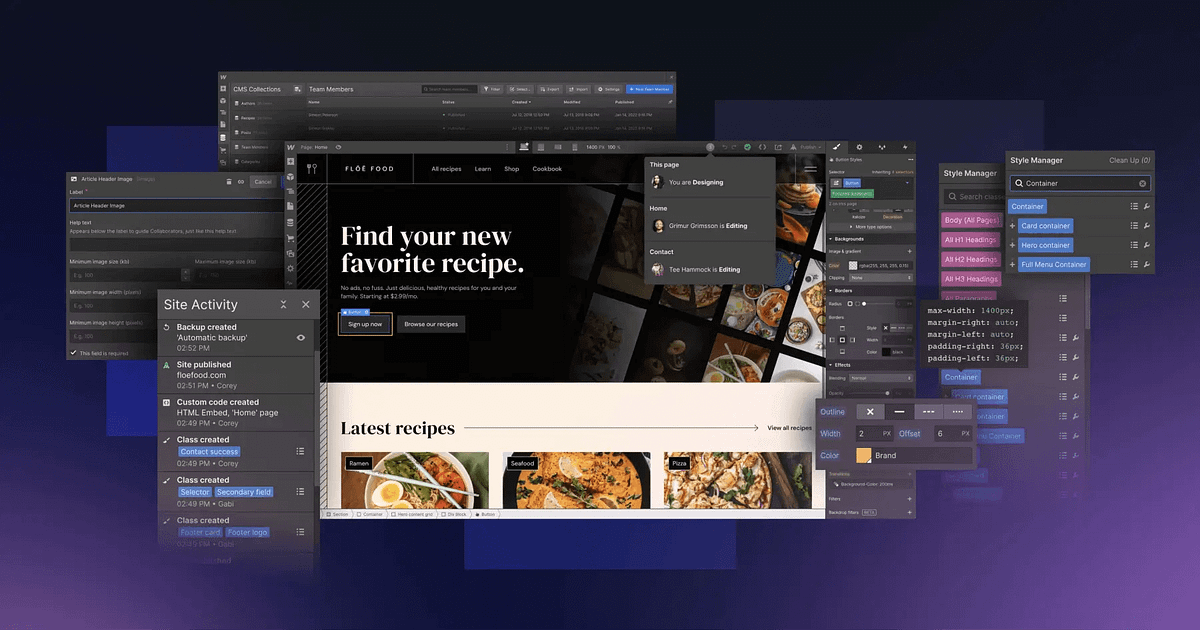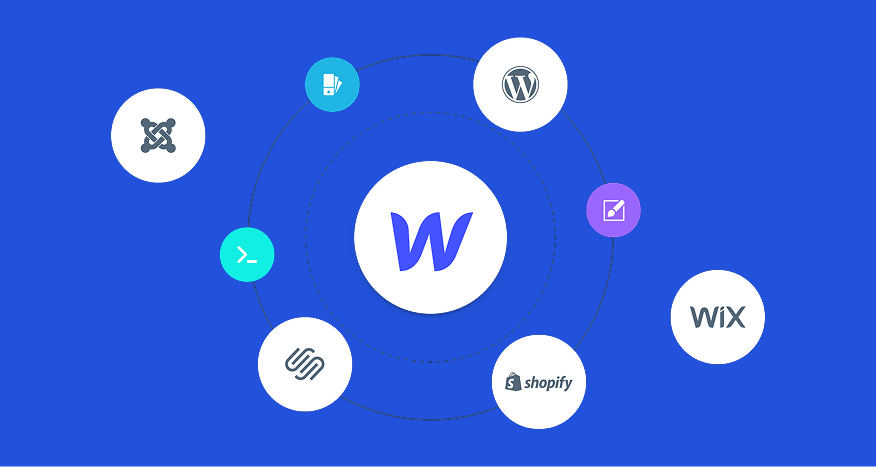Do Web Designers Use Webflow? Features, Benefits, and How It Compares to Other Tools
When I first started exploring web design tools I noticed how quickly the landscape was changing. Traditional coding skills still matter but platforms like Webflow are shaking things up. With its visual interface and powerful features Webflow promises to make designing and launching websites faster and more accessible.
I’ve seen more web designers talking about Webflow lately and it got me wondering—how many are actually using it in their daily work? Whether you’re just starting out or you’ve been in the industry for years it’s worth understanding how Webflow fits into the modern designer’s toolkit.
Understanding Webflow: An Overview

Webflow combines a visual drag-and-drop editor with advanced code export options, letting me design, build, and launch responsive websites without manual coding. Its key features—such as integrated CMS, dynamic content, and extensive interactions—address both design and functional demands for many web projects. I can visually create layouts and instantly preview them in real time, optimizing workflows for efficiency.
Key Webflow Features and Their Uses
| Feature | Description | Use Case Example |
|---|---|---|
| Visual Designer | Drag-and-drop page builder | Landing page creation |
| CMS | Custom content structures | Blog, news, portfolio sites |
| Interactions & Animations | Triggered motion and effects | Interactive menu, hover states |
| Responsive Design | Multi-device previews and tweaks | Mobile-friendly web app |
| Hosting & Deployment | Built-in SSL, fast CDN, custom domains | Portfolio, corporate websites |
| Code Export | Download clean HTML, CSS, JS | Handoff to external dev team |
Webflow Usage in Casino Website Design
Casino sites require multi-layered navigation, secure data handling, and visually engaging layouts. Webflow meets these demands by letting me visually build complex UI elements like account dashboards, game directories, and promotional banners while integrating secure hosting and responsive layouts. With Webflow’s CMS, I can manage dynamic casino content such as bonus offers or live game stats without server-side coding. Integration between Webflow and third-party services, like payment gateways or live chat for casino customer support, often relies on embed codes or external tools, further expanding its use in casino web projects. Webflow’s robust set of features and no-code approach allow me to address intricate design and content needs for industries that value reliability and visual appeal, like online casinos.
Why Web Designers Choose Webflow
Web designers rely on Webflow for its streamlined workflow and diverse functionality. I use the platform to deliver responsive, visually dynamic sites with speed and control.
Ease of Use and Intuitive Interface
Webflow’s interface displays all design elements in a visual context. I drag, drop, and edit components in real time without switching between design and code views. The learning curve stays shallow, so even designers new to the platform start building interactive sites quickly. For example, freelancers and agency teams skip complex development handoffs and make direct site updates within the same workflow.
Visual Design Capabilities
Webflow supports pixel-precise layouts, custom animations, and complex interactions. I access typography controls, global color palettes, and modern CSS features directly in the designer. The built-in Interactions panel lets me animate menus, images, or banners without plugins or scripts. Responsive controls make it straightforward to fine-tune different device breakpoints. E-commerce, portfolio, and SaaS projects benefit from this all-in-one visual flexibility.
Comparison of Visual Features: Webflow vs Alternative Tools
| Feature | Webflow | WordPress (Elementor) | Adobe XD |
|---|---|---|---|
| Real-Time Visual Editing | Yes | Partial | Yes |
| Built-in Responsive Controls | Yes | Yes | Yes |
| Native Animations & Interactions | Yes | Limited | Limited |
| Code Export | Yes | No | No |
Built-In Hosting and CMS Features
Webflow’s hosting integrates directly with its designer. I launch live websites through a global CDN, getting SSL and daily backups automatically. Webflow CMS gives me structured dynamic content—collections for blog posts, product catalogs, or portfolio items—without manual database setup. Updates happen instantly, and clients manage content via a secure editor. Project launch and long-term maintenance both run without third-party plugins.
| Feature | Webflow | Traditional CMS (e.g., WordPress) |
|---|---|---|
| Integrated Hosting | Yes | No |
| Auto SSL | Yes | Depends on host |
| Built-in Backups | Yes | Depends on host |
| Structured Content | Yes | Yes |
| Plugin Dependence | Low | High |
Comparing Webflow With Traditional Tools

Web designers rely on both Webflow and traditional platforms to deliver responsive, feature-rich sites. Each option offers strengths for different workflows, team sizes, and project requirements.
Webflow vs. WordPress
Webflow and WordPress both provide tools for modern website design. Webflow delivers a visual editor and integrated CMS, while WordPress uses themes and plug-ins for functionality. I see agencies and freelance designers frequently opt for Webflow when rapid prototyping, native animations, and reduced maintenance are priorities. WordPress, in contrast, excels when leveraging plug-in ecosystems and advanced blogging features.
| Feature | Webflow | WordPress (with Elementor) |
|---|---|---|
| Visual Editing | Native drag-and-drop, real-time updates | Plug-in-based (Elementor, WPBakery, etc.) |
| Hosting | Integrated, auto SSL, backups | External or managed, SSL via plug-ins |
| Maintenance | Managed, software auto-updates | Manual, frequent plug-in/theme updates |
| CMS | Built-in, visual fields | Built-in, more reliant on external plug-ins |
| E-commerce | Native, integrated analytics | Plug-in dependent (WooCommerce) |
| Animation/Effects | Built-in visual interactions | Limited, additional plug-ins required |
| Custom Code | Component-level insertion | Site-wide or theme-level customization |
Webflow vs. Hand Coding
Webflow and hand coding address distinct designer workflows. Webflow’s interface abstracts raw HTML, CSS, and JavaScript, letting me focus on structure and design. Hand coding provides maximum control over codebase specifics and custom integrations but requires more time and advanced skills for site setup and responsive adaptation.
| Attribute | Webflow | Hand Coding |
|---|---|---|
| Learning Curve | Moderate, visual-first | Steep, deep coding knowledge required |
| Speed | Fast for prototyping and launch | Slower initial setup and iteration |
| Flexibility | High for design, limited custom logic | Maximum, no visual restrictions |
| Maintenance | Managed hosting, less manual | Manual updates, security responsibility |
| Responsive Design | Visual breakpoints, device preview | Manually coded, more testing required |
| Collaboration | Built-in versioning, client handoff | Custom workflows, external tools needed |
Challenges and Limitations of Using Webflow
Webflow introduces several challenges for designers who prioritize efficiency and flexibility in their workflows.
- Steep Learning Curve for Advanced Features: Mastering complex animations, interactions, and CMS integrations in Webflow requires significant time investment, especially for designers unfamiliar with visual development tools.
- Limited Flexibility with Custom Code: Integrating highly customized solutions or unique third-party scripts often proves challenging, since Webflow restricts where I can insert custom code and sometimes prevents full backend access.
- Dependence on Webflow Hosting: Webflow-hosted projects don’t support external hosting. If clients or regulations demand specific server environments, this constraint complicates deployment and migration.
- Cost Structure Constraints: Webflow charges separately for each project or site, which increases overall costs for agencies or freelancers managing multiple client sites at once.
- No Native Support for Multilingual Sites: Webflow doesn’t provide built-in multilingual support. Managing sites in multiple languages requires third-party integrations like Weglot or manual duplication, adding complexity.
- Version Control Limitations: Collaborating on large projects becomes difficult, since there’s no git-like version control. Resolving design conflicts or tracking changes isn’t as robust as with code-based tools.
Table: Key Webflow Limitations for Designers
| Challenge | Impact on Workflow | Example Use Case |
|---|---|---|
| Advanced Features Learning | Delays project delivery | Complex animation for landing |
| Custom Code Restrictions | Blocks integration of unique solutions | Custom casino bonus widget |
| Hosting Dependency | Limits deployment options | Regulated casino environments |
| Pricing Per Project | Increases cost for multiple sites | Agency with 15+ client sites |
| Lack of Multilingual Support | Complicates global website launches | Casino sites in 5 languages |
| No Version Control | Hinders collaboration and rollback | Multi-designer casino projects |
Webflow’s well-defined structure supports rapid and visually rich site development, but these platform constraints shape how I approach projects with complex requirements, regulatory needs, or large content teams.
Who Should Use Webflow: Ideal Use Cases for Web Designers

Web designers find Webflow ideal for projects demanding rapid visual prototyping, real-time editing, and dynamic user experiences. I use Webflow to streamline workflows for tasks ranging from simple landing pages to complex client sites needing animation and custom CMS structures. The following table details specific design scenarios where Webflow delivers optimal results:
| Use Case | Description | Example |
|---|---|---|
| Landing Pages | Quickly launching visually rich pages for promotions or campaigns | Event registration pages, product launches |
| Portfolio Sites | Showcasing work with custom layouts and animations | Graphic designer portfolios, photographer sites |
| E-commerce Projects | Building online stores with integrated checkout and inventory management | Apparel shop, digital goods site |
| Content-Driven Blogs | Creating dynamic, scalable blogs with custom categories and author fields | Company blogs, publication sites |
| Responsive Web Applications | Designing interfaces that adjust seamlessly across devices | Interactive dashboards, booking systems |
| Agency Builds | Collaborating on multi-page client sites with robust style systems and symbols | Corporate websites, consulting agencies |
| Animation and Interaction Design | Prototyping advanced UI transitions without manual JavaScript | Product demos, explainer microsites |
Casino Website Design Needs Met by Webflow
Casino web projects consistently demand complex navigation, secure handling of content, and high-impact visuals. I rely on Webflow for these tasks, given its ability to support layered UI elements, robust CMS-driven pages, and integration of third-party marketing tools. I use the following features to address casino-specific requirements:
- Custom CMS Collections for dynamic bonus offers and promotions
- Advanced interactions to enhance user journeys
- Integrated SSL and secure hosting to meet regulatory standards
- Modular symbols and layout systems for quick updates across multi-tier games and tournaments
| Casino Design Requirement | Webflow Solution |
|---|---|
| Dynamic Promotions Management | CMS Collections and Filters for real-time content updates |
| Complex Navigation Menus | Custom navigation components and nested symbols |
| Regulatory and Security Compliance | Built-in SSL, password protection, and permission controls |
| Multi-language or Localized Content Support | Third-party integration (e.g., Weglot, Localize) |
| Fast Theming and Layout Iteration | Reusable components, global styles, and visual development workflow |
Web designers seeking visual control, faster iteration, and reduced reliance on external development find Webflow especially effective for both general and highly regulated industries.
Conclusion
Webflow’s place in the modern web design toolkit is hard to ignore. I see more designers embracing its visual power and flexibility for a wide range of projects. While it might not be the perfect fit for every scenario its ability to speed up workflows and enable creative freedom makes it a compelling choice. As web design continues to evolve I’ll keep looking for tools that help me deliver better results—and right now Webflow is definitely one of them.
Frequently Asked Questions
What is Webflow and how does it work?
Webflow is a web design platform that lets users visually build, launch, and manage responsive websites without manual coding. It features a drag-and-drop editor, integrated hosting, CMS, and dynamic content tools, making website creation fast and accessible for both beginners and experienced designers.
Why are web designers increasingly choosing Webflow?
Web designers favor Webflow for its streamlined workflow, real-time visual editing, and ability to quickly deliver responsive, visually appealing sites. Its intuitive interface, integrated CMS, and animation tools make it suitable for various projects, from simple landing pages to complex e-commerce sites.
How does Webflow compare to WordPress and Adobe XD?
Webflow excels in real-time visual editing and natively supports animations, hosting, and CMS features. Unlike WordPress, which relies on plugins, Webflow’s built-in features simplify maintenance. Compared to Adobe XD, Webflow allows for fully functional website launches, not just static prototypes.
Can Webflow be used for casino website design?
Yes, Webflow can efficiently handle the needs of casino websites. It supports complex navigation, secure data handling, dynamic content management (such as bonus offers), and integration with third-party services. This makes it valuable for projects that require reliability and strong visual impact.
What are some ideal use cases for Webflow?
Webflow is ideal for rapid prototyping, agency projects, portfolio sites, e-commerce, content-driven blogs, responsive web apps, and sites needing custom animations. It’s especially effective for projects that demand quick changes, dynamic content, and a visually polished user experience.
What are the main limitations of using Webflow?
Webflow’s main limitations include a steep learning curve for advanced features, limited custom code flexibility, required use of Webflow hosting, higher costs for multiple sites, lack of native multilingual support, and no robust built-in version control for team collaboration.
Is Webflow suitable for teams or agencies?
Webflow works well for freelancers and agency teams, especially for projects needing fast turnaround and impressive visuals. However, its cost structure and limited version control may be challenging for agencies managing many sites or large collaborative projects.
Do you need coding knowledge to use Webflow?
Basic coding knowledge isn’t required to use Webflow since it’s a visual builder. However, understanding HTML, CSS, or JavaScript can help unlock more advanced customizations. Most users can design and launch websites without writing code.
How does Webflow handle responsive design?
Webflow automatically generates responsive designs. Users can visually adjust layouts, content, and interactions for different screen sizes, ensuring websites look great on desktops, tablets, and smartphones without extra manual coding.
Can you export your site from Webflow to use on other hosting platforms?
Yes, Webflow allows you to export the HTML, CSS, and JavaScript of your site for external hosting if you’re not using the integrated CMS. However, CMS-driven content and interactions relying on Webflow’s servers aren’t exportable and require Webflow hosting.
